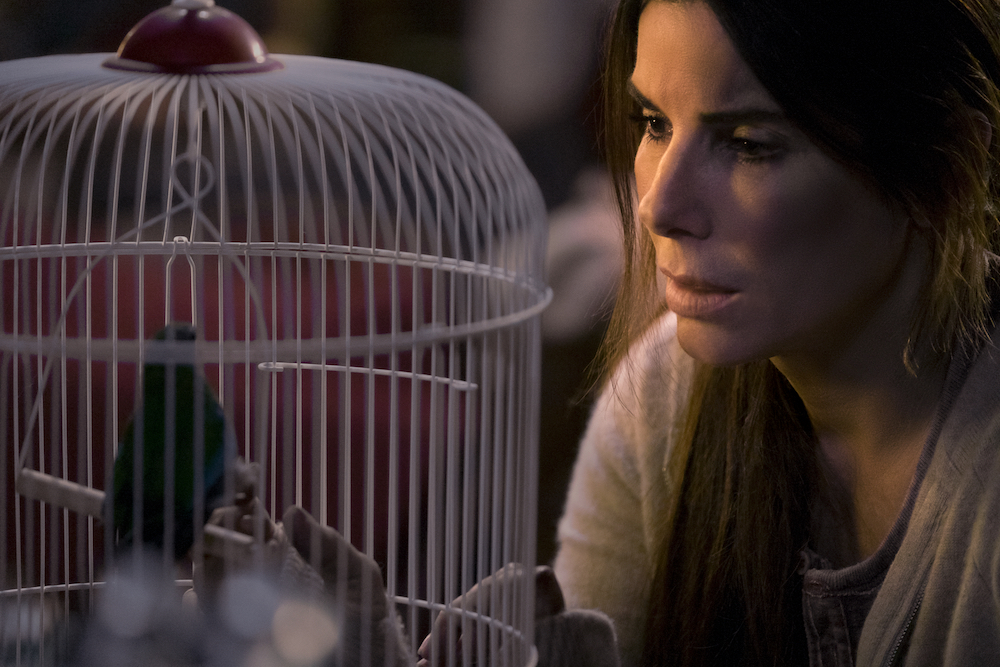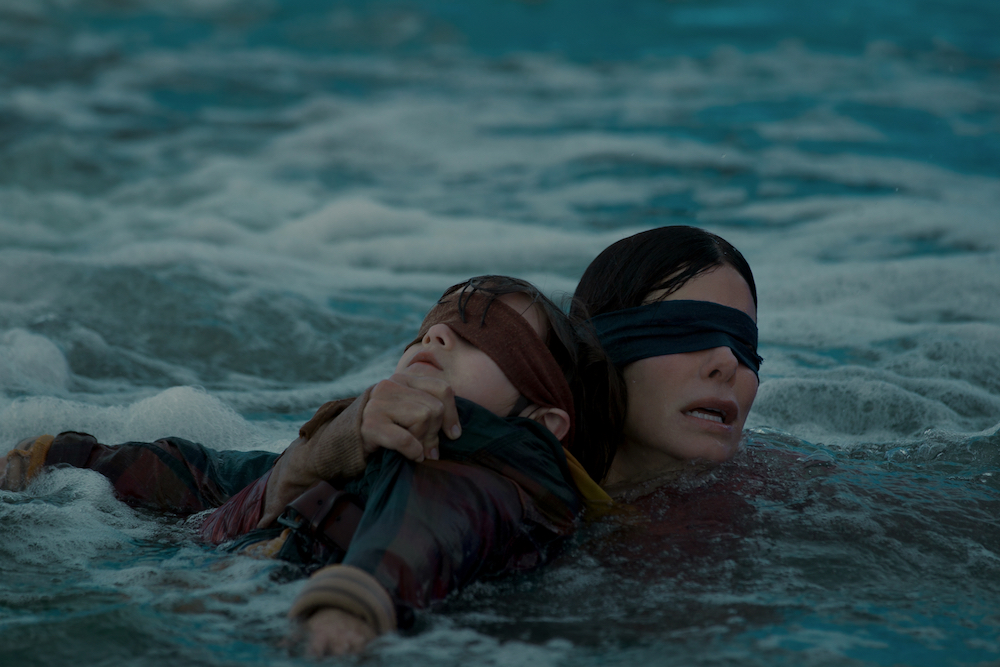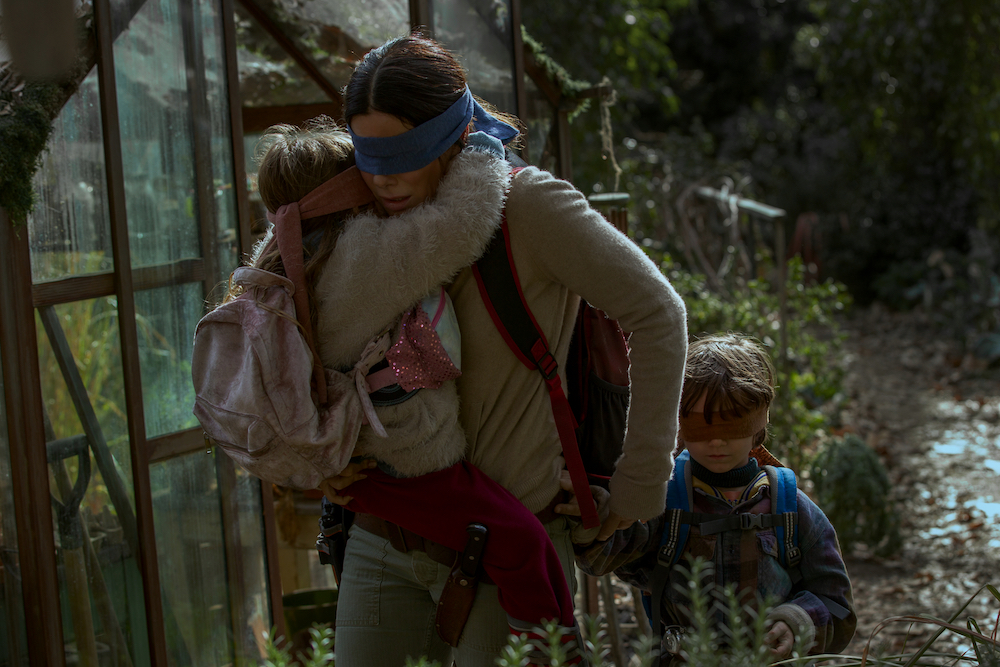Netflix thriller Bird Box director on filming an unfilmable book
Susanne Bier talks about the challenges of making her new Netflix thriller Bird Box starring Sandra Bullock
Plenty of books are labelled ‘unfilmable’ but the description does seem somewhat accurate for a story about a world populated with creatures which cause you to instantly kill yourself the moment you look at them. Josh Malerman’s novel Bird Box sees a group of strangers holed up in a blacked out house unable to leave without wearing blindfolds.
Danish director Susanne Bier – the first woman director towin an Oscar, an Emmy and a Golden Globe, has taken on the task for a Netflix original starring Sandra Bullock as Malorie, a reluctant parent trying to protect two small children from the possible end of civilisation. It’s a smart horror-thriller with echoes of A Quiet Place as she and a collection of survivors (including John Malkovich, Sarah Paulson, Moonlight‘s Trevante Rhodes and Alita: Battle Angel star Rosa Salazar) try to defend themselves again monsters they can never look at. (Check out the trailer)
Den of Geek caught up with Bier to talk about elevated horror, filming the unfilmable and whether she might be tempted by a James Bond movie…
How did you first come upon the material, and what made you decide you were up for making it into a movie?
I actually read the script before I read the book. I got a call, saying, “Read the script, because Sandra Bullock is interested in it.”
I read it really fast, and I got completely fascinated by the mix of genre. The joy of scares and all of that. But then the combination of a kind of metaphorical voyage of motherhood. That combination.
It was very intriguing, a very unconventional view of motherhood within a very mainstream conceit. I just felt that that was very, very interesting, and I loved it.
Did you go back and read the book after?
I did, yeah. And then in the course of preparation, there were a number of versions and reworkings of the script. So I haven’t been back to read the book. At this point in time, I can’t really remember what was in the book and what came out of development later on.
But I think that the thing that fascinated everybody about the book is still fascinating in the film.
One of the things I was dying to see was how you would be able to create something that the characters can’t look at, but the viewers can, the audience can.

Was that a daunting task? How did you envisage you would do the creatures, so that the characters can see them and we can’t?
The thing is, the creatures or whatever it is, it’s something that taps into your deepest fear. And that deepest fear, in nature, is bound to be individual. What you fear is not going to be the same as what I fear.
And therefore, that had to remain a mystery. So the challenge was to tell a story, to maintain the suspense, to maintain the scare without ever actually seeing what the victims see. I think that’s the reason why you stay with Malorie all the time. And Sandra Bullock, because she’s such a genius actress, actually manages to convey all her emotions. And we are so much with her – in spite of the fact that a big part of the time, we don’t see her eyes.
For an actress, the eyes are really important. It’s a bit like taking the brushes away from a painter. “Here you go. Do your painting. But you’ve got no brushes.” That’s like removing the eyes from an actress.
She does that. And you are with her. That’s just a kind of proof of her incredible talent.
The shoot must have been a challenge, particularly the sequences of Malorie and the two kids on the river?
That image, her blindfolded and holding two small kids, with a blindfold, in that landscape – that image was kind of what attracted me to the whole project. Because I just found that so compelling and so strong and intriguing.
I have to say, shooting in that hostile landscape – in that very beautiful but hostile landscape – was equally daunting, and equally challenging. I mean, she was literally blindfolded. For her to fight her way through trees and all sorts of things without being able to see, and kind of bumping into the camera, it was kind of… I had many sleepless nights.
It wasn’t dangerous, but it was extremely challenging. And she did bump into the camera a couple of times. I mean, she recovered.
How did you shoot the scene in the rapids where she and the kids go overboard?
Well, it’s a combination of them, they were there; of doubles; of stunts; of effects.
Some of it was shot in a tank. But shooting in a tank, it’s with small kids falling underwater. It’s actually scary.

How much did you go into the world-building of life before Malorie and the kids get in the boat?
We did quite a lot of: how did they survive? What did they eat? If you pay attention, you’ll see there are vegetables in the garden. So there is a sense that they were relatively self-sufficient.
You know, even if you don’t see it, you do feel it. I think it’s in the texture of whether it’s real or not. And we did make it real.
Are you a fan of horror, and do you see the movie as a horror film?
I see it as a thriller. I’m not a crazy horror fan. Some of them, I enjoy, but I’m actually more interested in suspense than actual horror. And that’s also part of what intrigued me about it.
Because you don’t ever see the beings, it does become more of a suspense film than a horror film, which is more up my valley than the other version of it.
It has some genre tropes, though. There are some scary moments. There’s a lot of tension…
No, no, it is a genre piece. It absolutely is a genre piece. But it’s a genre piece with hope and some kind of a heart. And I don’t think I would have done it otherwise.
There’s a term, “elevated horror” that people are talking about a lot at the minute. In the past, genre films haven’t really got a lot of respect. Do you think that’s something that’s changing with movies like Get Out and perhaps Hereditary?
I think it is changing. I think it is changing, because here’s the thing: if you look at this movie, it is a genre film, and it is an elevated genre film, no doubt about it.
It’s a very controversial description of a mother. It’s a woman who’s reluctantly pregnant. And she’s very harsh with her kids.
It’s a pretty controversial description of motherhood, and also a pretty unconventional description of a couple. In a sense, it’s a kind of seamless switch of gender. Tom is way more conventionally motherly. He’s the one who wants to tell stories to the kids. He has an ease about being warm and affectionate with them.
For me, it was very interesting, the ability to do something which is not conventional within a genre, and within something that is way more mainstream – in a way, it had a bigger impact than doing it within an arthouse film, which will more obviously lend itself to unconventional descriptions.
Was this movie always going to be a Netflix film?
Yeah. By the time I got involved, it was at a studio, and it was being bought by Netflix at the same time as I got involved with it. And I think part of the reason why it was possible to make it relatively unconventional is that it is a Netflix film. Which is also sort of the excitement for filmmakers to do a Netflix film.
What sort of freedom does that allow you? Did it affect you as a filmmaking knowing that most people would likely be watching this on a smaller screen at home?
You know, it’s made for the big screen, but it’s made consciously for the big screen with a very tight grip on the emotional attachment, which is why it’s going to work on a small screen as well.
It’s very beautiful on a big screen. It has epic landscapes, but it’s not epic in its timing and in its pacing. Which is why I know it’s going to work on an iPhone. I’m not going to enjoy everybody watching it on an iPhone, but I think it’s really going to work [laughs].

You’ve had an amazing career and done lots of terrific, independent stuff. Do you think you would ever be interested in moving into franchises?
I’d be interested in anything, where am I intrigued by it, and I feel I can do the movie I believe in. For me, it really isn’t about where or the context of it. For me, it’s about: do I actually feel that I know what the movie is? And do I understand it?
It needs to be a real challenge. I need to really feel like I’m climbing a new mountain every time I’m doing anything. That’s the only way to do my utmost. I need to have that challenge, and feel I can do a personal interpretation of the material.
I assume you’ve been asked this before, but post-The Night Manager, the obvious thing would be Bond. Is that something you would consider?
Yeah, of course I would.
In terms of The Night Manager, which was amazing and a huge success, is there any news on whether there’s likely to be a second series? And if there is, would you come back to it?
I would hate to feel that the mountain to climb would be hard – to do something different from what I did last time. Because the mountain you need to climb, it needs to be a complete investigation.
But whoever is going to do it, I’m sure is going to make a very, very exciting second season. And I will be involved in it, but I probably won’t direct it.
What is next for you?
I’m doing an HBO series, which is going to shoot in the beginning of next year.
Can you tell us a little bit about it?
It’s called The Undoing. It’s written by David Kelley, and it’s going to star Nicole Kidman and Hugh Grant. And it’s a thriller.
Bird Box is available to watch now on Netflix
